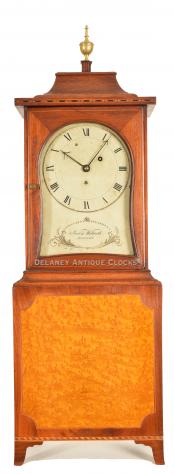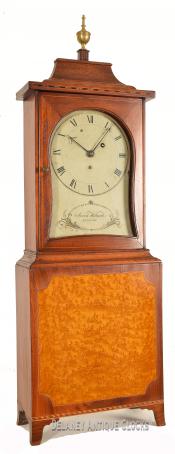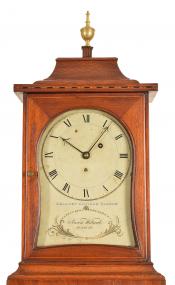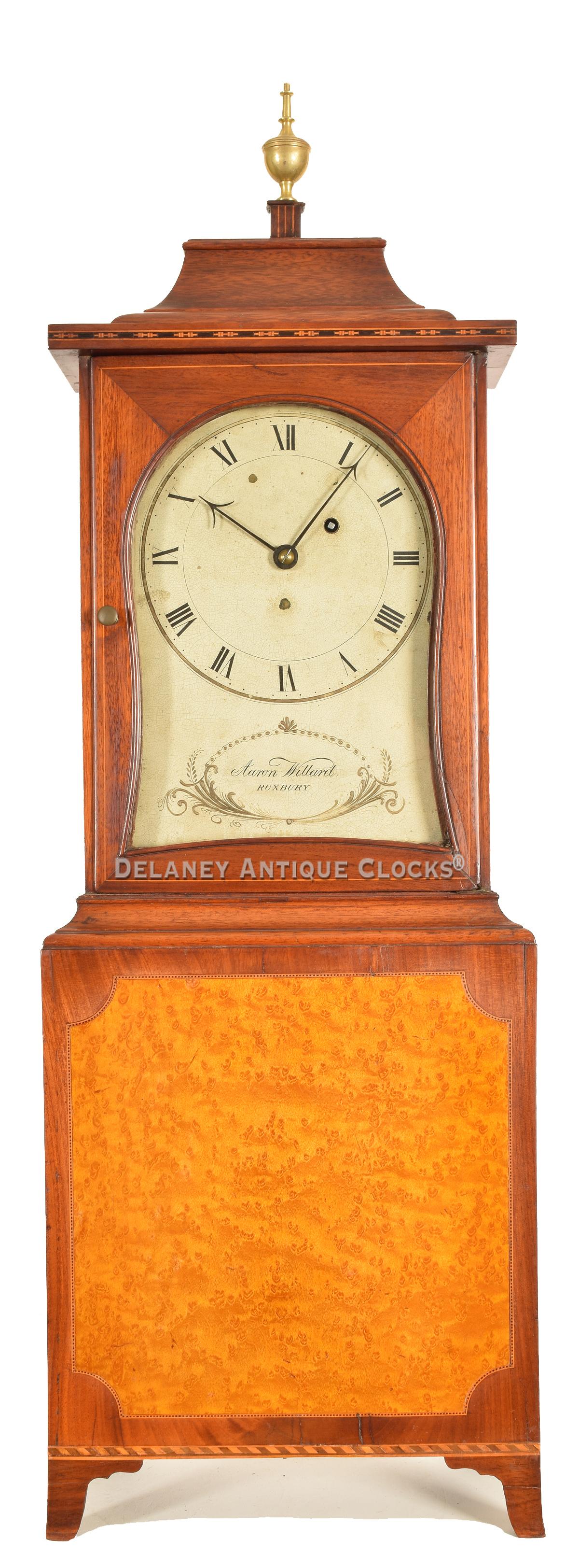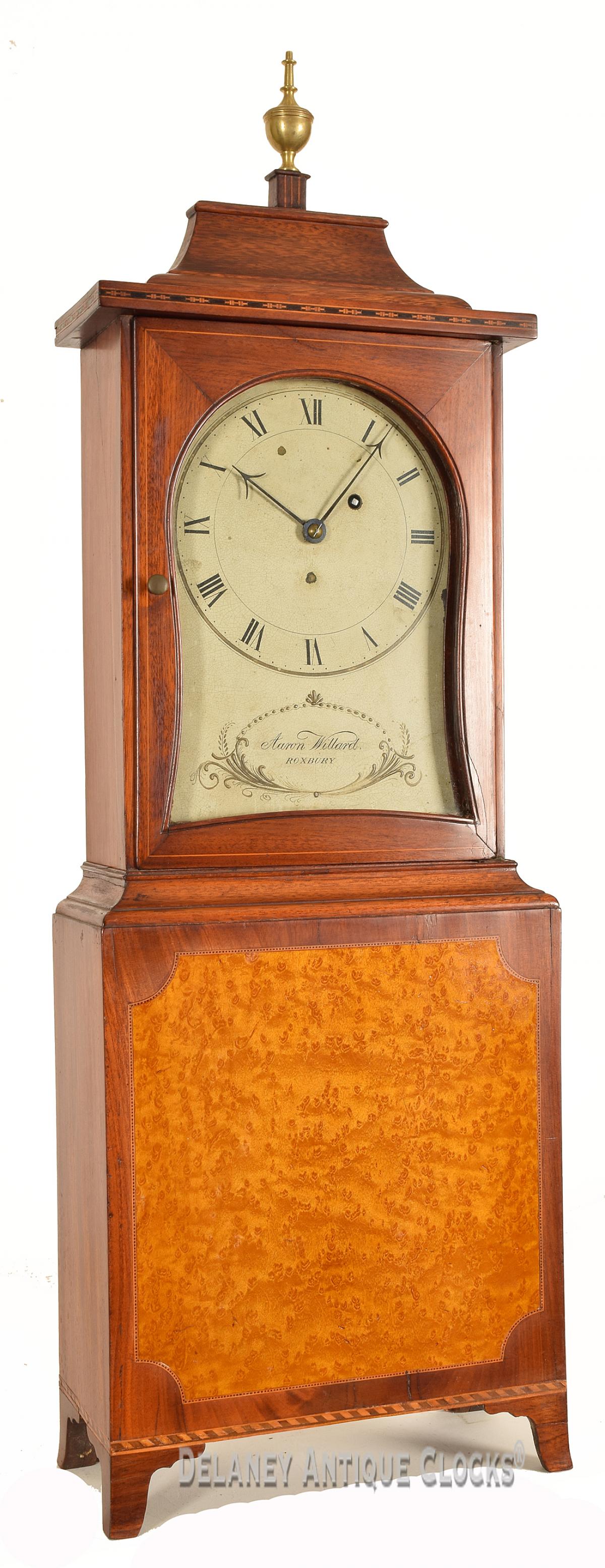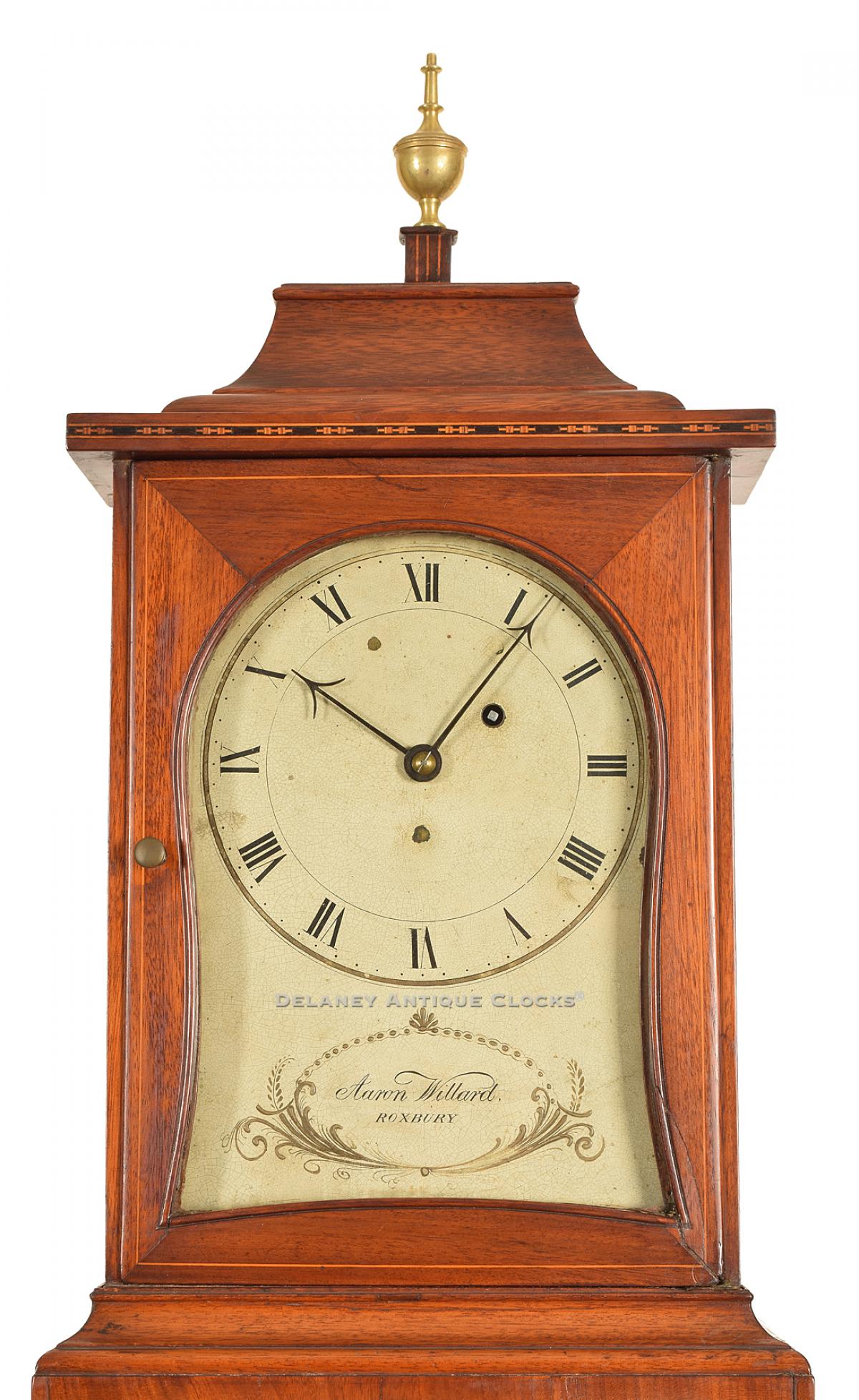Aaron Willard of Roxbury. A fabulous inlaid case Massachusetts shelf clock.
This Massachusetts Shelf Clock was made by Aaron Willard of Boston, Massachusetts circa 1795. The case is construction features mahogany, mahogany veneers, holey inlays, bird's-eye maple veneers and New England white pine. The surface has been wonderful refinish some 50 plus years ago.
This clock stands on four applied French feet. They are well formed and incorporating a gentle flare in the design at the bottom. The feet are separated from the base section by a line inlay. Above this is a pattern of inlay that is constructed from alternating woods of light and dark coloring. The base panel features a richly grained selection of bird's-eye maple veneer. The panel is well formed and features corners that are relieved. This veneered panel is trimmed with a complex line inlay pattern composed of a thin line that frames tiny consecutive black squares. The hood is fitted with a door that frames the kidney shaped dial. The door is decorated with line inlay. An additional pattern of complex inlay is used across the molding above the door. Set above this is a shaped molding that supports a line inlaid plinth. This is fitted with a brass urn shaped finial. The dial is fitted to the case with a pine mask board.
The painted iron was manufactured and painted by Spencer Nolen in Boston. It features a time ring that is formatted with Roman style hour numerals, dotted minute markers and a gilt ring. Below the time ring is a decorative area that one will find the Clockmaker's signature. The signature is boldly signed in a script format. The working location of "ROXBURY" is presented in block lettering. Gesso is applied to the surface of the dial to slightly raised the designs. This is then highlighted with gilt paint.
The weight powered time-only movement is constructed in brass. The gearing is supported by steel shafts and polished steel pinions. The escapement is a recoil format. This movement is designed to run for an eight-day duration and is good quality. It is a timepiece and is very good quality.
This very attractive example was made circa 1795 and stands approximately 35 inches tall, 14 inches wide and 6.5 inches deep.
Aaron Willard was born in Grafton, Massachusetts, on October 13, 1757. Little is currently known of Aaron's early life in Grafton. His parents, Benjamin Willard (1716-1775) and Sarah (Brooks) Willard (1717-1775) of Grafton had eleven children. Aaron was one of four brothers that trained as a clockmaker. In Grafton, he first learned the skills of clock-making from his older brothers Benjamin and Simon. It is recorded that Aaron marched with them in response to the Lexington Alarm on April 19, 1775, as a private under Captain Aaron Kimball's Company of Colonel Artemus Ward's Regiment. Aaron re-enlisted on April 26 and was soon sent by General George Washington as a spy to Nova Scotia in November. By this time, he had reached the grade of Captain. He soon returned to Grafton to train as a clockmaker. In 1780, Aaron moved from Grafton to Washington Street in Roxbury along with his brother Simon. Here the two Willards establish a reputation for themselves as fine clock manufacturers. They were both responsible for training a large number of apprentices. Many of these became famous clockmakers in their own right. The Willards dominated the clock-making industry in the Boston area during the first half of the nineteenth century. Aaron worked in a separate location in Roxbury from his brother and, in 1792, relocated about a quarter-mile away from Simon's shop across the Boston line. Aaron is listed in the 1798 Boston directory as a clockmaker "on the Neck," His large shop employed up to 30 people, while 21 other clockmakers, cabinetmakers, dial and ornamental painters, and gilders worked within a quarter-mile radius by 1807.
Some important dates for Aaron Willard include...
1783, Aaron married Catherine Gates. They have two children. The first is Aaron Willard Jr who becomes a very accomplished clockmaker. Catherine Gates dies in 1785.
1789, Aaron marries Polly Patridge. Polly has two sisters that also marry clockmakers Abel Hutchins and Elnathan Taber. Aaron and Polly have nine children. Two work-in-the-clock trades. George Willard 1817-1821 becomes a journeyman clockmaker. Henry Willard (1822-1887) trained as a cabinetmaker and made cases for the Willard operation when he came of age.
1792, Aaron builds a large home at 143 Washington Street in Boston. He lives in this house until he dies. This house is also the location of his workshop. A barn is converted into an area to finish wood. Other spaces in the carriage shop are rented to related artisans.
1802-1804, Aaron is in a business partnership with cabinetmaker James Blake as Willard & Blake. Aaron's position is financial.
1804, Aaron he transforms the carriage house and barn into a workshop space for artists, clockmakers, woodworkers, etc. It is now known as Willard's Compound.
1805-1806, Aaron is a financial backer in the partnership of Willard & Nolen. Spencer Nolen (1784-1849) is an ornamental artist who begins painting clock dials. In 1808, Spencer Nolen married Aaron Willard's daughter.
1823, Aaron Willard retires. He is 66 years old.
1844, Aaron died on May 20 and is buried in the Eustis Cemetery in Roxbury.
We have owned a large number of tall case clocks made by this important Maker. In addition, we have also owned a good number of wall timepieces, some in the form of banjo clocks, gallery clocks, as well as numerous Massachusetts shelf clock forms.

